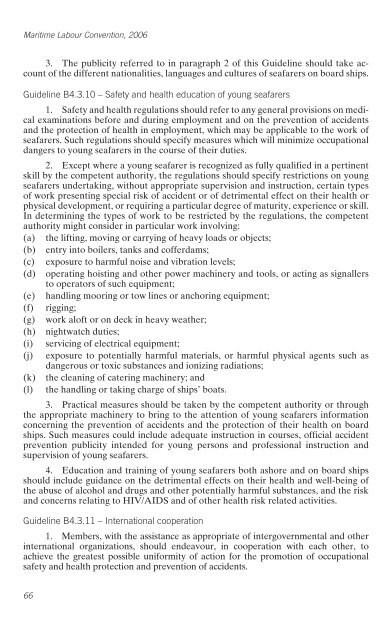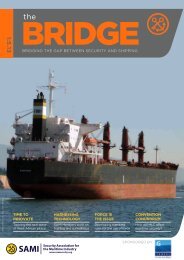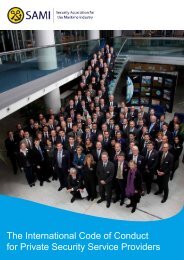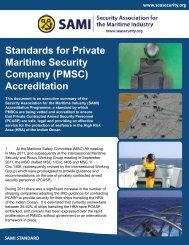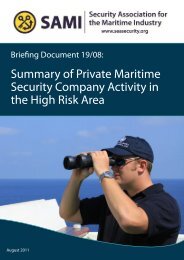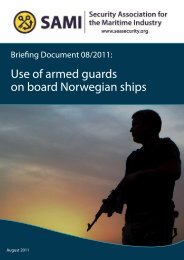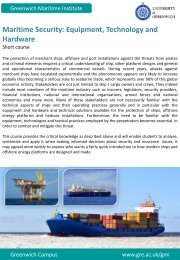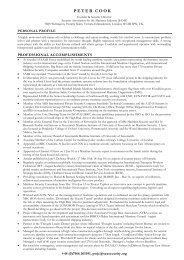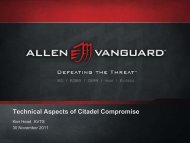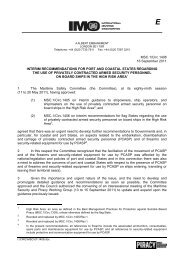SAMI Briefing Maritime Labour Convention FAQs and Text March 2013
SAMI Briefing Maritime Labour Convention FAQs and Text March 2013
SAMI Briefing Maritime Labour Convention FAQs and Text March 2013
You also want an ePaper? Increase the reach of your titles
YUMPU automatically turns print PDFs into web optimized ePapers that Google loves.
<strong>Maritime</strong> <strong>Labour</strong> <strong>Convention</strong>, 20063. The publicity referred to in paragraph 2 of this Guideline should take accountof the different nationalities, languages <strong>and</strong> cultures of seafarers on board ships.Guideline B4.3.10 – Safety <strong>and</strong> health education of young seafarers1. Safety <strong>and</strong> health regulations should refer to any general provisions on medicalexaminations before <strong>and</strong> during employment <strong>and</strong> on the prevention of accidents<strong>and</strong> the protection of health in employment, which may be applicable to the work ofseafarers. Such regulations should specify measures which will minimize occupationaldangers to young seafarers in the course of their duties.2. Except where a young seafarer is recognized as fully qualified in a pertinentskill by the competent authority, the regulations should specify restrictions on youngseafarers undertaking, without appropriate supervision <strong>and</strong> instruction, certain typesof work presenting special risk of accident or of detrimental effect on their health orphysical development, or requiring a particular degree of maturity, experience or skill.In determining the types of work to be restricted by the regulations, the competentauthority might consider in particular work involving:(a) the lifting, moving or carrying of heavy loads or objects;(b) entry into boilers, tanks <strong>and</strong> cofferdams;(c) exposure to harmful noise <strong>and</strong> vibration levels;(d) operating hoisting <strong>and</strong> other power machinery <strong>and</strong> tools, or acting as signallersto operators of such equipment;(e) h<strong>and</strong>ling mooring or tow lines or anchoring equipment;(f) rigging;(g) work aloft or on deck in heavy weather;(h) nightwatch duties;(i) servicing of electrical equipment;(j) exposure to potentially harmful materials, or harmful physical agents such asdangerous or toxic substances <strong>and</strong> ionizing radiations;(k) the cleaning of catering machinery; <strong>and</strong>(l) the h<strong>and</strong>ling or taking charge of ships’ boats.3. Practical measures should be taken by the competent authority or throughthe appropriate machinery to bring to the attention of young seafarers informationconcerning the prevention of accidents <strong>and</strong> the protection of their health on boardships. Such measures could include adequate instruction in courses, official accidentprevention publicity intended for young persons <strong>and</strong> professional instruction <strong>and</strong>supervision of young seafarers.4. Education <strong>and</strong> training of young seafarers both ashore <strong>and</strong> on board shipsshould include guidance on the detrimental effects on their health <strong>and</strong> well-being ofthe abuse of alcohol <strong>and</strong> drugs <strong>and</strong> other potentially harmful substances, <strong>and</strong> the risk<strong>and</strong> concerns relating to HIV/AIDS <strong>and</strong> of other health risk related activities.Guideline B4.3.11 – International cooperation1. Members, with the assistance as appropriate of intergovernmental <strong>and</strong> otherinternational organizations, should endeavour, in cooperation with each other, toachieve the greatest possible uniformity of action for the promotion of occupationalsafety <strong>and</strong> health protection <strong>and</strong> prevention of accidents.66


